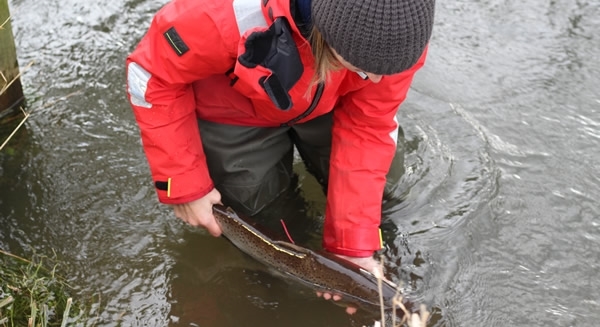
Help us to understand what happens to trout at sea
By Dylan Roberts, Head of Fisheries
As a life-long fisherman, I have fond memories of catching my first sea trout as a boy. The sight of a sea trout – or sewin as we know them in Wales – leaping in abundance, was a joy to behold, Our rivers were full of these enigmatic fish. Sadly, today our sea trout are in serious trouble with stocks at historic lows.
If we don’t act now, your grandchildren might have to be incredibly lucky to see one in our rivers.
A BIGGER PROBLEM THAN OUR RIVERS
There are many causes for this decline including loss and degradation of their freshwater habitat, but what our research shows is that for every young sea trout leaving the river, over 80% of them will not return as adults.
This not only affects the number of fish at sea, but has a real impact on the number of fish returning to our rivers in future years. So what is happening to them at sea?
UNLOCKING THE MYSTERY OF WHAT HAPPENS AT SEA
New technology can help us to understand what happens when our sea trout reach marine waters. Data storage tags, about 1 inch in size, are inserted into adult sea trout and record temperature and depth every 2 minutes.
By combining these measurements with information such as sea temperature and topography of the sea bed we can use data models to reconstruct their most likely migration route, swimming depth and habitat use at sea.
YOU CAN MAKE A DIFFERENCE TO SEA TROUT SURVIVAL
This is the first time the marine behaviour of sea trout has been studied in such detail. The true impact of fishing and dredging in areas important to sea trout is largely unknown. We hope that this study will help to reduce unintended disturbance and exploitation. This will improve the survival rate of sea trout, increasing the number of adult returners and help to recover the populations in our local rivers.
We are working in partnership with the government bodies who decide the regulations of coastal fishing and developments, so this work could make a real difference to how our rivers are managed.
THE TIMING IS VITAL
Time is running out to reverse this decline. You can help us to sharpen our understanding of marine mortality and make a real difference. You will have noticed the growth of coastal renewable energy schemes such as tidal lagoons and underwater turbines.
We don’t yet know the impact these have on fish survival or, importantly, if they are being located in areas which could harm fish. Your support in buying new tags could help us find the answers to help our sea trout.
Taking advantage of new technology isn’t cheap. Each tag costs £300 and we hope to buy 300 tags across the duration of the project. Thankfully, the SAMARCH project is co-funded by the EU’s Interreg channel programme, meaning that they contribute 69% of the overall cost. However, we must pay for each tag upfront, so funds are essential if we are to fulfil the potential of this project.
SUPPORT THIS WORK BY BUYING A TAG FOR JUST £93
By donating £93 (or £75 plus Gift Aid), you will cover the entire cost of a data storage tag to the GWCT and make a real contribution to the future of sea trout survival. This could provide an important insight to improve the way we manage coastal areas in order to reduce mortality. All donors will receive updates about the findings from the tags we recover.
If you can, a donation of £125 will support not only the purchase of a tag, but also catching a sea trout and fi tting the tag humanely. Please give whatever you can to support our work today.
Donate now >